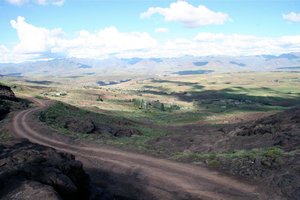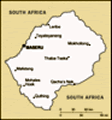Advertisement
Published: March 26th 2010

 Lesotho
Lesotho
Our first view of MalealeaSouthern Africa - Lesotho
Tuesday 17th March
Our journey back towards Cape Town takes us through the mountain kingdom of
Lesotho for a couple of days. The kingdom was formed when the
Basotho people were forced into the
Drakensburg and
Malutimountains as a defence against the Zulus and Boers in the Nineteenth Century.
Probably because of these origins and because of their remote position in the mountains they have managed to retain a lot of their culture and traditions and avoid becoming part of South Africa. It is some of this culture that we are hoping to see during our short stay here. The downside of the
Basotho holding on to a lot of their traditional beliefs is that it is going to be difficult for us to take photographs of people, particularly when we are trying to photograph people in the traditional costume of a colourful blanket and the rather special straw hat that the Basotho like to wear.
The country certainly does have a different feel to it as, as soon as we cross the border from South Africa, several people shake my hand and welcome me to Lesotho and as we drive through the

 The Evening Entertainment
The Evening Entertainment
Home made instruments and shoulder dancingcountry we have to wave at people as though we were members of the Royal Family!
Malealea Lodge
Our destination is
Malealea Lodge in southern
Lesotho for a couple of days. We pass through the “Gates Of Paradise” {
That’s the second time within a week that we’ve been to paradise!} with some stunning views of Lesotho’s mountains before arriving at Malealea.
The lodge tries to integrate itself as much as possible with the local communities, is involved in a lot community schemes and has won responsible tourism awards for Southern Africa. Every time we drink a beer in the bar some of the money goes to community projects, we are encouraged to donate to local schools and become involved in a tree-planting scheme.
In the evenings we are entertained by local choirs and bands. The choirs certainly have a different “sound” to other African choirs I have heard - there is something distinctive and different about their music. I am particularly impressed with groups of local youths who have formed themselves into bands.
They have learned music, built their own home-made instruments, learned to play together and come to entertain us -

 In The Village
In The Village
The yellow flag means that there is alcohol for sale hereand they are obviously enjoying the music they make! I can’t help comparing them with groups of teenagers at home who are always “bored” because there is “nothing to do”. The guys also break out into a style of dancing which seems to be based mostly on moving the shoulders - brilliant!
A Walk Through Malealea
We hire a local guide, Max, to take us on a walking tour of the
Malealea area and to some San rock paintings. The Malealea area is made up of eight different villages; there is a chief for the area with a sub-chief {
deputy chief? assistant chief?} for each village. The current chief is a woman but as soon as her son is old enough {
21 I think} he will take over.
Our first stop on our tour through the village is a house that also acts as the local pub. A yellow flag outside the house tells us that alcohol is on sale here. Different coloured flags outside other houses indicate what’s on sale there {
white - tobacco; red - meat; green - vegetables}. Inside we are shown the process for brewing the local beer. It’s made
from raisins and only takes two days to brew. It’s bottled into whatever empty bottles are available and I don’t think it stays fermenting in the bottles too long before it is drunk. We are offered a sample but as it’s not even 9 in the morning yet we all just have a “polite sip”
From here we go into the village primary school. We cause chaos when a group of foreigners walk into the classroom. The children here have 10 different lessons, some of which are taught in English. Some of the children we speak to can make themselves understood quite well in English - indeed Max, our guide, speaks English very well and I think he learned it just in the village schools. There are 9 classes in the school with, I guess, between 30 and 50 kids in each class. We are told that most of the children here go on to secondary school - there is a secondary school very close by which serves the Malealea area. Fees have to be paid for secondary school and this is one of the areas where a fund set up by the lodge helps out. The young teacher

 In The Local School
In The Local School
Keeping the kids under control, as always!!we meet has just completed his first level of teacher training and yet seems to be trying to teach every class we walk into at the same time! He was also the organiser for one of the local choirs who sang for us!
Our walk then takes us out of the village towards the caves with the rock art we want to see. The walk takes about an hour through some amazing mountain scenery and, fortunately, with a bit of cloud cover. We scramble a bit up to the caves where the paintings are. The paintings are estimated to be 10,000 years old. They were painted by the
San people {
Bushmen} who themselves were forced out by the arrival of the Basotho. Again Max does an excellent job in explaining the paintings to us.
We stop for lunch in one of the caves where we are soon joined by two people and their dog. They stare at us for about half an hour while we eat lunch and they talk to Max about us. Now I know how that elephant at the waterhole in Swaziland felt when we watched it for about half an hour! I think they
are so intrigued by us because we have brought lunch for Max and they want to know where Max got his bag of mini-cheddars from and if there are any more!
”You Are Going To Go On A Long Journey”
One of the consequences of Lesotho retaining a lot of it’s traditional culture is that the
Sangoma, or Witch Doctor, is still a very respected and powerful person in the community. Two of us from our group decide that we need a consultation with the Sangoma. {
I’m not sure why I’m suddenly so keen to do this. I don’t believe in any sort of fortune telling, I’m not superstitious (apart from lucky pants for football) and I don’t even look at a horoscope.}
Like any doctor’s appointment we are kept waiting in the waiting room for an hour. {
OK It’s not that bad. The “waiting room” is the bar of the lodge, the sun is shining, I have a cold beer and Bob Dylan music is drifting out of the bar}. The Sangoma is fashionably late but he’s a powerful man so we can’t complain. Eventually I get invited into his hut. He doesn’t

 San Rock Paintings
San Rock Paintings
More than 10,000 years oldspeak any English but has his translator with him. {
By amazing coincide the translator is Mr Musi who Roy met this morning when he went off in search of “Mr Musi’s Donga” - but that’s another story! } I put my money inside the circle of beads he has placed on the ground and he shakes his collection of bones, shells and dice and drops them into the circle. He says a prayer over these and then its my turn to shake the bones, shells and dice. He tells me to cut down on sugar, salt and fatty meat.{
I really don’t think he needed to look at the bones to work that one out!!}. He also tells me that I need to throw a party and say a prayer to my ancestors so that I’ll continue to have good luck - sounds like a good excuse for a party!
Advertisement
Tot: 0.115s; Tpl: 0.011s; cc: 9; qc: 26; dbt: 0.0582s; 1; m:domysql w:travelblog (10.17.0.13); sld: 1;
; mem: 1.1mb









